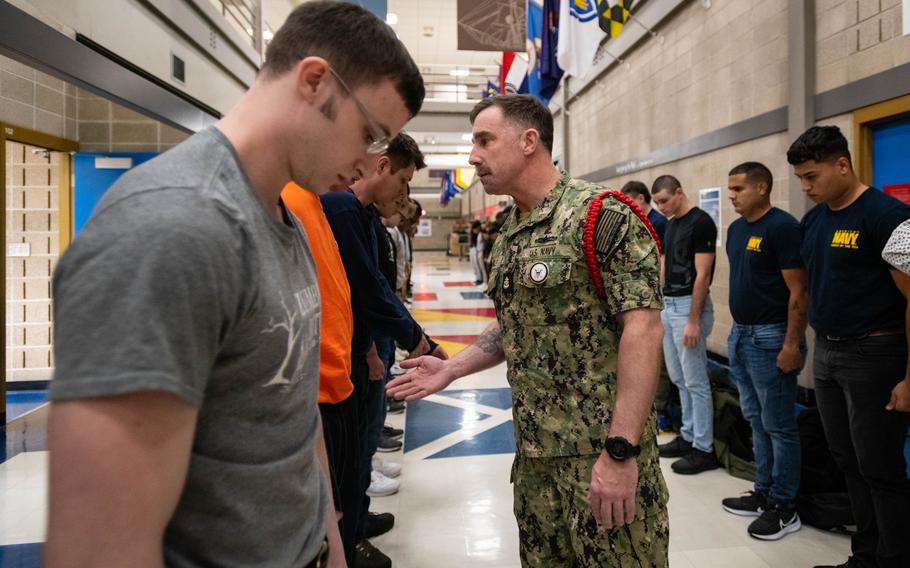
A staff member motivates new Navy recruits on April 19, 2023, as they line up inside the in-processing center at the service’s Recruit Training Command at Naval Station Great Lakes, Ill. Boot camp is approximately 10 weeks and all enlistees into the Navy begin their careers at the command. More than 40,000 recruits train annually at the Navy’s only boot camp. (Olympia O. Martin/U.S. Navy)
WASHINGTON — The Navy has launched a new training program that’s designed to get future sailors in shape so they can pass physical fitness requirements, which are keeping many young Americans from joining the military amid serious recruiting challenges.
In recent years, three of the service branches — the Navy, Army and Air Force — have struggled to hit recruiting goals due to several factors. One of the biggest reasons is fewer than 25% of Americans between the ages of 17 and 24 can pass academic and physical testing to join the military, according to recent Pentagon data.
“We expect to be about 6,000 [recruits] short [this year],” Adm. Lisa Franchetti, vice chief of naval operations, said earlier this week during a congressional hearing about military readiness. “[We are] doing better than [when] we started, but about 6,000 short is our projection.”
All three services are making significant efforts to improve recruiting, such as offering incentives for referrals and enlistees and developing various targeted strategies to help more young Americans meet eligibility requirements. The Navy launched its Future Sailor Preparatory Course Physical Fitness Track pilot program this month, which service leaders expect will help grow the candidate pool of qualified sailors. The idea is to get recruits on the path to physical fitness as early as possible so they can get a jump on passing the Navy Physical Readiness Test.
“The Future Sailor Preparatory Course is about building the complete person,” said Rear Adm. Jennifer Couture, commander of the Naval Service Training Command. “The individuals who are participating have a sincere desire to serve their country.”
The Navy said the course was designed to “mitigate societal trends that have reduced the available pool” of candidates who meet service entry standards.
There are many requirements to pass the Physical Readiness Test. For example, men between the ages of 17 and 19 must be able to do 50 situps in 2 minutes, 42 pushups in 2 minutes and run a mile and a half in 12 minutes and 30 seconds. Women in the same age range must do 50 situps in 2 minutes, 19 pushups in 2 minutes and run a mile and a half in 15 minutes and 30 seconds. The requirements across the board vary by age and gender. Recruits also must be able to pull their own weight and there’s a limit on body fat. For example, a man who is 6 feet tall can have a maximum weight of 201 pounds.
The Navy’s Future Sailor Preparatory Course — open to anyone with body fat within 6% above the maximum allowable amount — lasts for three weeks and is located at Naval Station Great Lakes, Ill. The Navy’s only boot camp is located at the base, which is north of Chicago.
“As an all-volunteer force, the Navy depends on the citizenry to fill the ranks,” the service said in a statement. “Removing barriers and developing citizens with a desire to serve is a way to adjust to societal realities, without lowering standards.”
The first prep course class began earlier this month with only male students, but the Navy said women recruits will begin participating in the summer.
“The men and women we recruit to participate in this program have the desire and commitment to be sailors,” said Rear Adm. Alexis Walker, commander of Navy Recruiting Command. “[The course] is going to help our recruiters identify individuals who can be great assets to the fleet and give them the tools and the opportunities they need to excel.”
Last year, the Navy barely hit its recruiting target of 33,400 active-duty enlisted sailors — but fell about 2,000 short of its goal for Reserve enlisted sailors. The service was 200 short of active-duty officer accessions and about 400 shy for Reserve officers.
The Navy’s new prep course is modeled on a similar program that the Army started last year at Fort Jackson, S.C. The Army Future Soldier Prep Course so far has seen more than 4,000 of its graduates advance to Basic Combat Training.
Gen. James McConville, the Army chief of staff, has said 98% of the people selected for that prep course so far have improved their scores enough to enlist. The course has been so successful, in fact, the Army has taken it to a second base — Fort Benning, Ga.
Participants who don’t improve enough in the Navy’s program to qualify for basic training can retake the course as many as four more times. Those who don’t meet the physical enlistment requirements after their fifth try will be evaluated for continued service, the Navy said.
In October, after multiple classes have cycled through the program, the Navy will evaluate the Future Sailor Preparatory Course and determine whether to keep it going or make changes.